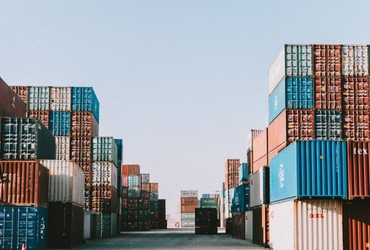
Guide to shipping container dimensions
A short history to shipping container dimensions
The idea of loading merchandise onto trucks, then moving onto trains or ships and then loading them back onto trucks came about over 60 years ago. It originated from a small-time truck hauler by the name of Malcolm McLean from Maxton, North Carolina.
McLean greatly improved this process by placing merchandise into containers so that entire containers can be lifted and loaded from the chassis. The next step was to standardize the shipping container dimensions for easy handling by trucks, trains, ships and ports around the world.
This standardization of shipping container dimensions made a substantial global impact on world trade. It allowed manufacturers to load goods at their factories and ship directly to stores and warehouses without having to unload and transfer their cargo along the way. This meant that manufacturing processes could be located far away from customers but still provide customers with an unimaginable variety of low-cost goods from across the globe. Today, there are 5,000 freighters carrying over 14 million containers to ports all over the world.
Types of containers and their dimensions: which is best for you
ISO standard containers have been customized to meet the demands of exporters and importers in international trade. With 12 different ocean shipping container types and a variety of sizes to choose from within those types, it’s possible to ship everything from bulk grains and raw materials to perishable commodities. If you want to know the space required for your cargo, check our cubic meter calculator.
In this guide, we will walk you through the different ocean container types and their shipping container dimensions including:
- 20 ft dry shipping container
- 40 ft dry shipping container
- 40 ft dry high cube shipping container
- 45 ft dry high cube shipping container
- 20 ft flat rack shipping container
- 40 ft flat rack shipping container
- 20 ft open top shipping container
- 40 ft open top shipping container
- 20 ft ventilated shipping container
- 20 ft refrigerated shipping container
- 40 ft refrigerated shipping container
- 20 ft tank shipping container
Standard shipping container dimensions
The 20 ft standard shipping container and the 40 ft standard shipping container are two of the most widely used containers in the world to transport ocean freight goods.
The standard shipping containers differ from other types of containers in that they are completely airtight. These hermetically sealed shipping containers are not equipped with cooling nor ventilation systems like the refrigerated and ventilated containers.
The 20 ft standard shipping container can hold up to 10 standard pallets or 11 Euro pallets across its floor base.
The standard shipping containers are also known as dry shipping containers or dry vans.
![]()
20 ft standard shipping container dimensions
Container Reference Code:
22GP
Container Application:
The 20 ft standard shipping container is for general purpose cargo.
Container Dimensions:
Width Height Length
Door opening in feet 7' 8 ⅛" 7' 6 ¼"
Door opening in meters 2.34 m 2.29 m
Interior dimensions in feet 7' 8 ⅝" 7' 6 ¼" 19' 4 ¼"
Interior dimensions in meters 2.34 m 2.29 m 5.9 m
Container Weight
Max Gross Tare Max Payload
Weight in lbs 52,831 lbs 4,914 lbs 47,899 lbs
Weight in kg 23,956 kg 2,229 kg 21,727 kg
Container Volume In CFT In CBM
Load Capacity 1,172 CFT 33.2 CBM
40 ft standard shipping container dimensions
Container Reference Code:
42GP
Container Application:
The 40 ft standard shipping container is for general purpose cargo.
Container Dimensions:
Width Height Length
Door opening in feet 7' 8 ⅛" 7' 6 ¼"
Door opening in meters 2.34 m 2.29 m
Interior dimensions in feet 7' 8 ⅝" 7' 10 ¼" 37' 11 ¼"
Interior dimensions in meters 2.352 m 2.395 m 12.01 m
Container Weight
Max Gross Tare Max Payload
Weight in lbs 67,199 lbs 5,220 lbs 59,039 lbs
Weight in kg 30,481 kg 3,701 kg 26,780 kg
Container Volume In CFT In CBM
Load Capacity 2,389.75 CFT 67.67 CBM
40 ft high cube standard shipping container dimensions
Container Reference Code:
40HQ or 40HC
Container Application:
The 40 ft high cube shipping container is larger than the 40 ft standard shipping container.
Container Dimensions:
Width Height Length
Door opening in feet 7' 8 ⅛" 8' 6 ¼"
Door opening in meters 2.34 m 2.56 m
Interior dimensions in feet 7' 8 ⅝" 8' 10 ⅛" 39' 5 ⅝"
Interior dimensions in meters 2.352 m 2.69 m 12.01 m
Container Weight
Max Gross Tare Max Payload
Weight in lbs 67,196 lbs 8,747 lbs 58,448 lbs
Weight in kg 30,480 kg 3,968 kg 26,512 kg
Container Volume In CFT In CBM
Load Capacity 2,694 CFT 76.3 CBM
45 ft high cube standard shipping container dimensions
Container Reference Code:
L5GO
Container Application:
The 45 ft high cube shipping container is for general purpose cargo.
Container Dimensions:
Width Height Length
Door opening in feet 7' 9½" 8' 5 ¾"
Door opening in meters 2.37 m 2.58 m
Interior dimensions in feet 7' 11" 8' 10" 44' 4 ¾"
Interior dimensions in meters 2.41 m 2.69 m 13.53 m
Container Weight
Max Gross Tare Max Payload
Weight in lbs 74,960 lbs 10,910 lbs 64,050 lbs
Weight in kg 3,4000 kg 4,950 kg 29,050 kg
Container Volume In CFT In CBM
Load Capacity 3,122 CFT
Ventilated shipping container dimensions
The 20 ft ventilated container is a shipping container that offers a ventilation system due to its lateral openings that permit air flow and circulation.
These characteristics make it suitable for the transportation of goods that require constant temperature and conditions.
Thanks to its ventilation system, the 20 ft ventilated container is able to expel hot air and allow fresh air to enter, thus preventing condensation and humidity changes that may damage the cargo.
One of the main products transported in the ventilated container is coffee, which is why it may also sometimes also be known as the “coffee container”.
20 ft ventilated shipping container dimensions
Container Reference Code:
22VH
Container Application:
The 20 ft ventilated shipping container is for cargo that requires ventilation, typically used to transport green coffee beans or similar cargo.
Container Dimensions:
Width Height Length
Door opening in feet 7' 8 ⅛" 7' 6 ¼"
Door opening in meters 2.34 m 2.29 m
Interior dimensions in feet 7' 8 ⅝" 7' 10 ¼" 19' 4 ¼"
Interior dimensions in meters 2.352 m 2.395 m 5.9 m
Container Weight
Max Gross Tare Max Payload
Weight in lbs 52,897 lbs 5,297 lbs 47,899 lbs
Weight in kg 32,500 kg 2,394 kg 21,727 kg
Container Volume In CFT In CBM
Load Capacity 1,172 CFT 33.2 CBM
Refrigerated shipping container dimensions
Refrigerated shipping containers, also known as reefer containers, are equipped with a system that helps to maintain an internal temperature of between -25º and + 25º. Contrary to popular belief, these refrigerated containers do not regulate temperatures, they can only maintain them.
There are certain types of refrigerated containers that are capable of maintaining temperatures as low as -60º.
Although refrigerated containers have integrated systems that help with maintaining the internal temperature, the container must be connected to an external power source such as the vessel’s generator or the port’s power supply.
When booking a reefer container, it is important to make sure that necessary equipment is available throughout the entire international transport chain (from pick up to drop off) to help power the container and maintain its internal temperature.
Reefer containers are most commonly used to transport fresh and frozen foods such as fish, meat, fruits, and other perishable items. It is also regularly used to transport medicines and pharmaceutical products.
20 ft refrigerated shipping container dimensions
Container Reference Code:
22RT
Container Application:
The 20 ft refrigerated shipping container is for cargo that requires temperature control.
Container Dimensions:
Width Height Length
Door opening in feet 7' 8 ⅛" 7' 6 ¼"
Door opening in meters 2.34 m 2.29 m
Interior dimensions in feet 7'6" 7' 4 ⅞" 17' 11 ⅝"
Interior dimensions in meters 2.28 m 2.33 m 5.45 m
Container Weight
Max Gross Tare Max Payload
Weight in lbs 67,200 lbs 6,970 lbs 60,230 lbs
Weight in kg 30,480 kg 3,160 kg 27,320 kg
40 ft refrigerated shipping container dimensions
Container Reference Code:
42RT
Container Application:
The 40 ft refrigerated shipping container is for cargo that requires temperature control or perishable cargo.
Container Dimensions:
Width Height Length
Door opening in feet 7' 5 ⅜" 6' 11 ⅞"
Door opening in meters 2.26 m 2.13 m
Interior dimensions in feet 7'5 ⅜" 7' 1 ⅞" 37' 11 ¼"
Interior dimensions in meters 2.26 m 2.18 m 11.48 m
Container Weight
Max Gross Tare Max Payload
Weight in lbs 67,053 lbs 10,778 lbs 56,275 lbs
Weight in kg 30,415 kg 4,889 kg 25,526 kg
Container Volume In CFT In CBM
Load Capacity 2,039.7 CFT 57.76 CBM
Flat rack shipping container dimensions
Flat rack shipping containers are designed to transport merchandise whose overall measurements and/or weight prevent them from fitting into a standard container.
These containers are made of metal plates that fit a standard structure of 20 or 40 feet. Its sides are collapsible and it does not have a roof or top. This makes it easy for top- or side-loading. Such features make flat rack containers suitable for transporting:
- Heavy or over-sized cargo such as construction equipment, building supplies or heavy machinery. These cargoes usually need to be loaded onto the flat rack with a crane or other special equipment.
- Goods with a height higher than that of a 20 or 40 ft high cube container or irregularly shaped goods such as industrial vehicles or pipes.
Because the flat rack container has no side or top to protect the cargo, extra care must be taken to prevent damage by weather conditions such as heavy rain or strong winds. Lashing the cargo will help secure the cargo and make sure it stays in its place.
When booking a flat rack shipping container, make sure to clearly indicate lifting points for your over- or odd-sized cargo to avoid damages — especially for heavy machinery. Remember to also specify any special handling instructions to your freight forwarder.
20 ft flat rack shipping container dimensions
Container Reference Code:
22PC
Container Application:
The 20 ft flat rack shipping container is for unusually heavy loads, over-sized cargo, construction equipment, building supplies or heavy machinery.
Container Dimensions:
Width Height Length
Interior dimensions in feet 8' 7' 3 ⅞" 19' 9 ¾"
Interior dimensions in meters 2.438 m 2.233 m 5.638 m
Container Weight
Max Gross Tare Max Payload
Weight in lbs 99,200 lbs 6,400 lbs 92,800 lbs
Weight in kg 45,000 kg 2,900 kg 42,100 kg
Load Capacity 1,154.3 CFT 32.7 CBM
40 ft flat rack shipping container dimensions
Container Reference Code:
42PC
Container Application:
The 40 ft flat rack shipping container is for over-sized cargo, heavy machinery, construction equipment, or supplies.
Container Dimensions:
Width Height Length
Door opening in feet NA NA
Door opening in meters NA NA
Interior dimensions in feet 7' 4" 7' 5 ⅓" 39' 3 ⅞"
Interior dimensions in meters 2.23 m 2.27 m 11.98 m
Container Weight
Max Gross Tare Max Payload
Weight in lbs 98,326 lbs 12,897 lbs 85,429 lbs
Weight in kg 44,600 kg 5,850 kg 38,750 kg
Container Volume In CFT In CBM
Load Capacity 1,860 CFT 52.7 CBM
Open top shipping container dimensions
Open top containers, be it 20 ft or 40 ft, fall within the category of standard containers, despite not having a roof.
The type of goods typically transported in open top containers is essentially the same as those being transported in flat rack containers, but with more irregular heights.
Some examples include goods that are too heavy for manual handling and must be lifted and loaded with a crane, or top-protruding merchandise that cannot fit into a 40 ft high cube standard container.
Unlike the flat rack, which also has no roof, open top containers have walls to protect the goods. A tarpaulin will be needed to cover the top to protect the merchandise.
Note that the opening of an open top shipping container through which you load your cargo is slightly smaller than the container’s interior. This is similar to the door of a regular container and it’s for structural integrity purposes. In other words, there is less room to work with for maneuvering when loading your cargo through the top of an open top shipping container.
A 20 ft open top container has a maximum load of approximately 28 metric tons, while the 40 ft open top container can hold up to 30 metric tons.
Due to low demand for open top containers, some carriers may find it difficult to secure cargo requiring open top containers to be able to send the containers back to the origin. As such, carriers may implement an extra cost to transport open top containers, which can vary according to the destination.
When booking an open top shipping container, make sure lifting points for your over- or odd-sized cargo are well-indicated to avoid damages and specify handling instructions to your freight forwarder.
20 ft open top shipping container dimensions
Container Reference Code:
22U1
Container Application:
The 20 ft open top shipping container is for over-height cargo and top loading.
Container Dimensions:
Width Height Length
Door opening in feet 7' 8 ⅛" 7' 6 ¼"
Door opening in meters 2.34 m 2.29 m
Interior dimensions in feet 7' 8 ⅝" 7' 10 ¼" 19' 4 ¼"
Interior dimensions in meters 2.352 m 2.395 m 5.9 m
Container Weight
Max Gross Tare Max Payload
Weight in lbs 52,897 lbs 5,297 lbs 47,619 lbs
Weight in kg 23,994 kg 2,394 kg 21,600 kg
Container Volume In CFT In CBM
Load Capacity 1,172 CFT 33.2 CBM
40 ft open top shipping container dimensions
Container Reference Code:
42OT
Container Application:
The 40 ft open top shipping container is for top loading for excessively long or high cargo.
Container Dimensions:
Width Height Length
Door opening in feet 7' 8 ⅛" 7' 6 ¼"
Door opening in meters 2.34 m 2.29 m
Interior dimensions in feet 7' 8 ⅝" 7' 10 ¼" 39' 5 ⅝"
Interior dimensions in meters 2.352 m 2.395 m 12.01 m
Container Weight
Max Gross Tare Max Payload
Weight in lbs 67,196 lbs 8,487 lbs 58,709 lbs
Weight in kg 30,480 kg 3,850 kg 26,630 kg
Container Volume In CFT In CBM
Load Capacity 2,389.75 CFT 66.67 CBM
ISO tank shipping container dimensions
ISO tank or ISO containers are containers specially designed to transport liquids or gases. They can hold bulk cargoes ranging from perishable liquids such as oil or wine to hazardous substances.
Additional requirements will need to be fulfilled when shipping hazardous substances in ISO tanks. And once an ISO tank has been tagged to ship hazardous substances, it can no longer be used to ship food, and vice versa.
The ISO tank is supported on a structure that can be adjusted according to its dimensions. It’s also lined with an insulating material that protects it from the cargo it’s transporting.
ISO tanks offer one of the most effective intermodal transportation methods for bulk cargo. They are safer, offer more flexibility, are more environmentally friendly, and relatively cheaper than other options such as OTR tank trucks.
The most commonly used ISO tanks measure 20 or 40 ft there are also 10 and 30 ft long ISO tanks. They’re also widely known as ISO containers or tank containers.
20 ft ISO tank shipping container dimensions
Container Reference Code:
22TO
Container Application:
The 20 ft tank shipping container is for food stuffs, oils, and chemicals.
Container Dimensions:
Width Height Length
Exterior dimensions in feet 8' 8' 6" 20"
Exterior dimensions in meters 2.43 m 2.59 m 6.09 m
Container Volume In U.S. Gallons In Liters
Load Capacity 6,450 gl 26,001 lt
How to quote and book non-standard shipping containers
At iContainers, we offer the 20 ft and 40 ft standard container, as well as the 40 ft high cube standard container. You may get your quote for any of these types of containers in seconds by searching on our website.
If shipping irregular cargo, the dimensions and weight of the merchandise determine which ocean container type can best accommodate your shipment. This information and a photograph or spec sheet must be submitted to your freight forwarder, who will handle the booking with the shipping line. They will then give you a detailed assessment of fees and customize your cargo solution.
If you’re interested in booking other ocean shipping container types, please contact our sales representatives.
- 1. A short history to shipping container dimensions
- 2. Types of containers and their dimensions: which is best for you
- 3. Standard shipping container dimensions20 ft standard shipping container dimensions40 ft standard shipping container dimensions40 ft high cube standard shipping container dimensions45 ft high cube standard shipping container dimensions
- 4. Ventilated shipping container dimensions20 ft ventilated shipping container dimensions
- 5. Refrigerated shipping container dimensions20 ft refrigerated shipping container dimensions40 ft refrigerated shipping container dimensions
- 6. Flat rack shipping container dimensions20 ft flat rack shipping container dimensions40 ft flat rack shipping container dimensions
- 7. Open top shipping container dimensions20 ft open top shipping container dimensions40 ft open top shipping container dimensions
- 8. ISO tank shipping container dimensions20 ft ISO tank shipping container dimensions
- 9. How to quote and book non-standard shipping containers
Related Articles


